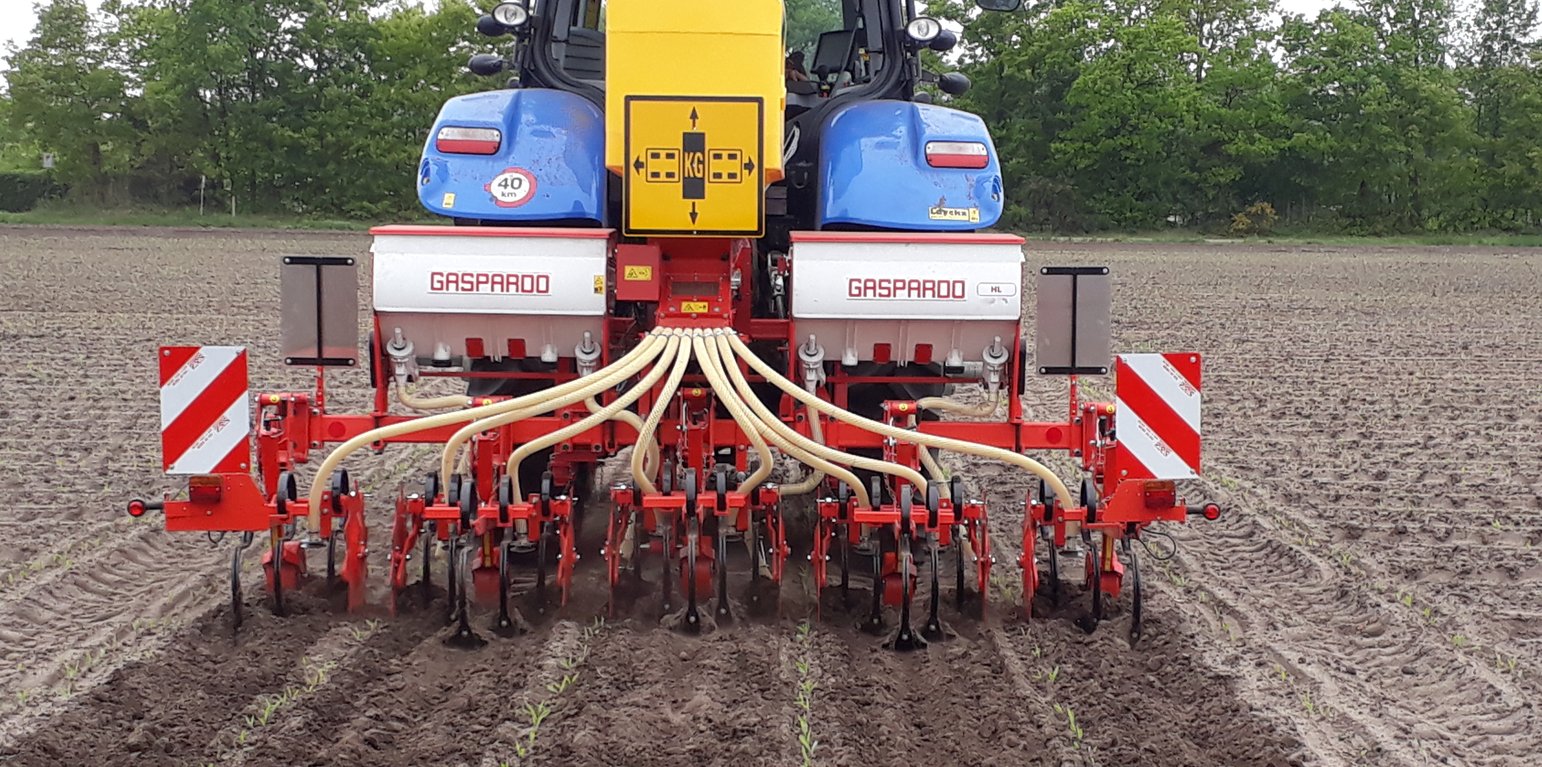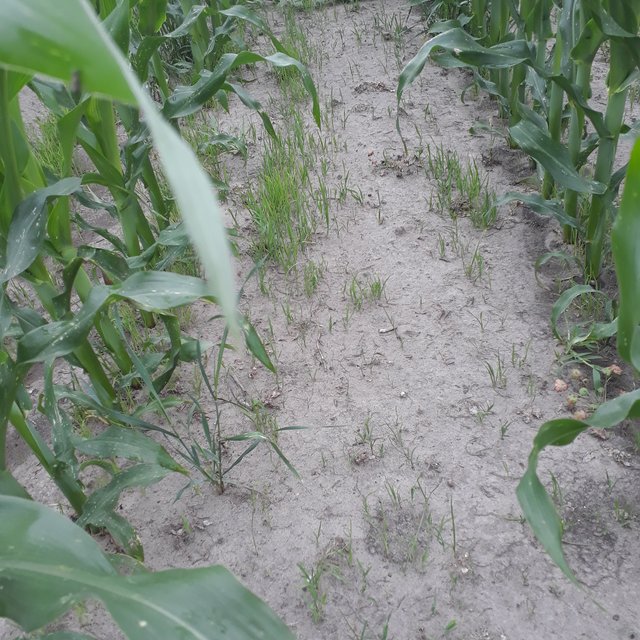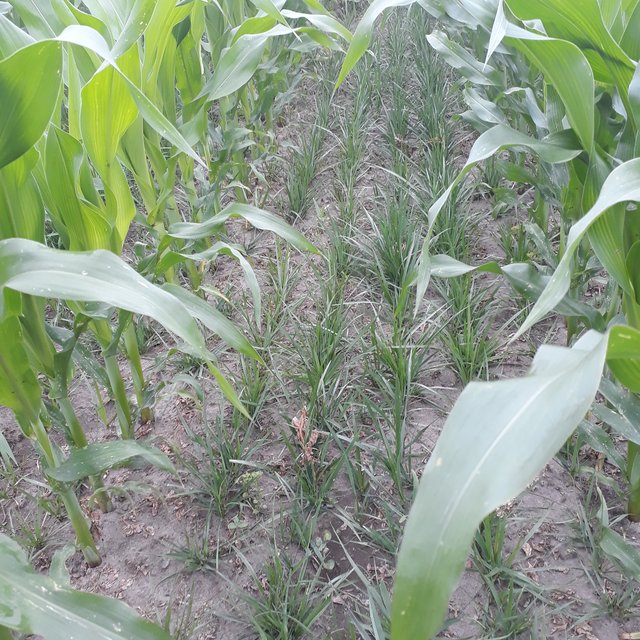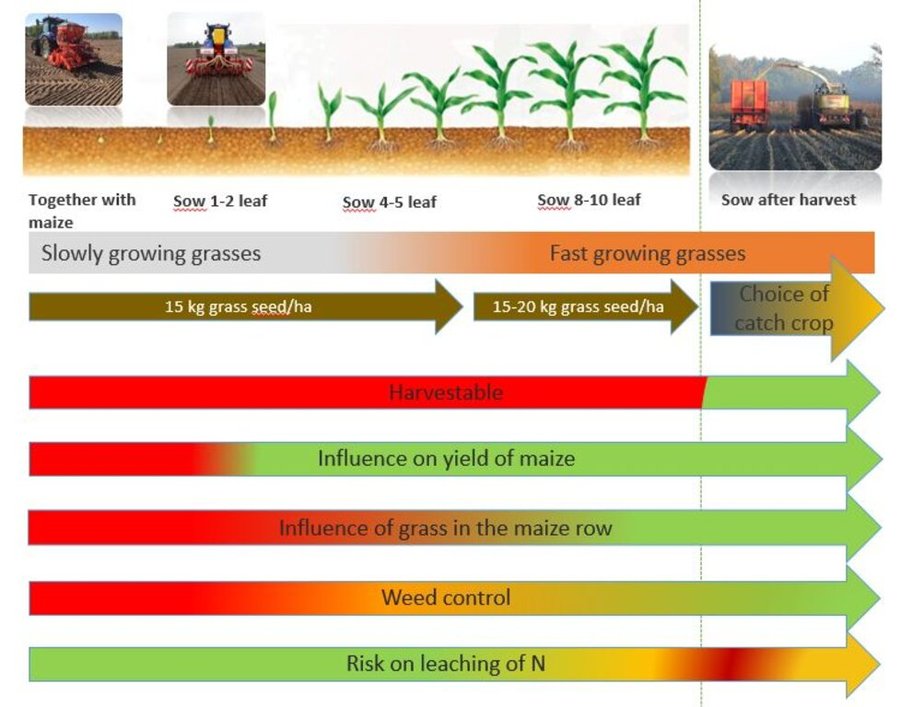



Hooibeekhoeve (a farm education and research facility) started to experiment with undersowing in 2015. The aim was to have a well-developed catch crop/cover crop in the field during autumn and winter that could prevent nitrogen leaching. Initially, the grass was sown together with the maize, or when the maize reached the 8-10 leaf stage. But both techniques have their weaknesses and a better alternative proved to be undersowing the grass at the 4-6 leaf stage. This has been the practice since 2019, and gives the best of both worlds.
Considerations regarding time of undersowing include the following:
•Sowing at the 8-10 leaf stage is often confronted with adverse the field/weather conditions which are almost never optimal.
•Sowing together increases competition between grass and maize, and therefore lower yields of maize: however, the earlier you sow the grass, the better the effect on prevention of nitrogen leaching.
•Timing of sowing has an influence on the choice of grass and the amount of seed required:
- Early stage (simultaneous sowing and at the 1-2 leaf stage): tall fescue (Festuca arundinacea) develops and grows slowly and therefore leads to less competition with the maize: 15 kg/ha of seed is required.
- When sowing at the 4-6 leaf stage, a combination of perennial ryegrass (Lolium perenne) and cocksfoot (Dactylis glomerata) is the preferred grass mixture: again, sown at 15 kg/ha. The effect on maize yield is even positive when sowing at this stage - possibly due to the mechanical weed control, which stimulates mineralisation.
- Sowing at the 8-10 leaf stage: Italian ryegrass (Lolium multiflorum) is used at 20 kg/ha. This has the vigour to grow under the maize when maize is already tall enough tolerate this dominating grass.
The grass must be sown between, and not within the maize rows. A motorised hoe with seed box is used. This machine weeds between the rows of the maize and at the same time sows the grass. RTK-GPS tracking is needed to do this correctly.
Weed control is not an easy job in this system, and the earlier you sow the grass, the more difficult is the problem. Because there are two different crops in the field at the same time, you have to keep both in consideration when selecting plant protection products. Therefore, it is not recommended to use this technique in fields with high weed pressure, especially not where there are grassy weeds.
After the harvest, the cover crop – grass – has already formed a dense carpet. This gives protection to the soil during harvest and no further soil tillage is needed, or desirable in the autumn. The grass can then be ploughed in or killed with a herbicide in the early-spring ready for a new crop.
This undersowing technique demonstrates a decrease of N residue compared to ‘no catch/ cover crop’ and ‘sowing of catch/ cover crop after harvest’ every year and at every location. This is a positive finding. However, farmers find it hard to implement, due to the possible negative effect on the yield of the maize and difficulties with weed control.
ສະຖານທີ່: Antwerpen, ເບສຢຽມ
ຈໍານວນ ພື້ນທີ່ ທີ່ໃຊ້ ເຕັກໂນໂລຢີ ທີ່ໄດ້ວິເຄາະ: 2-10 ພຶ້ນທີ່
ການແຜ່ກະຈາຍຂອງເຕັກໂນໂລຢີ: ແຜ່ຂະຫຍາຍຢ່າງໄວວາໃນພື້ນທີ່ (approx. 0.1-1 ກມ 2)
ຢູ່ໃນເຂດປ່າສະຫງວນທີ່ບໍ?: ບໍ່ແມ່ນ
ວັນທີຂອງການປະຕິບັດ: 2015
ປະເພດຂອງການນໍາສະເໜີ





| ລະບຸ ປັດໃຈ ນໍາເຂົ້າ ໃນການຜະລີດ | ຫົວໜ່ວຍ | ປະລິມານ | ຕົ້ນທຶນ ຕໍ່ຫົວໜ່ວຍ (Euro) | ຕົ້ນທຶນທັງໝົດ ຂອງປັດໃຈຂາເຂົ້າ ໃນການຜະລິດ (Euro) | % ຂອງຕົ້ນທຶນທັງໝົດ ທີ່ຜູ້ນໍາໃຊ້ທີ່ດິນ ໃຊ້ຈ່າຍເອງ |
| ແຮງງານ | |||||
| Chemical weed control (product & labour) | ha | 1.0 | 70.0 | 70.0 | 100.0 |
| ອຸປະກອນ | |||||
| Hoeing combined with sowing cover crop | euro/ha | 1.0 | 70.0 | 70.0 | 100.0 |
| ວັດສະດຸໃນການປູກ | |||||
| Seed cover crop | euro/kg | 15.0 | 25.0 | 375.0 | 100.0 |
| ຕົ້ນທຶນທັງໝົດ ທີ່ໃຊ້ໃນການບໍາລຸງຮັກສາ ເຕັກໂນໂລຢີ | 515.0 | ||||
| ຄ່າໃຊ້ຈ່າຍທັງໝົດ ສຳລັບການບົວລະບັດຮກສາເຕັກໂນໂລຢີ ເປັນສະກຸນເງີນໂດລາ | 565.93 | ||||
Depends on the time of undersowing (+ in 4-leafstage)
More difficult in use of plant protection products (2 crops at same time in field)
Less leaching of N and other nutrients
Since the cover crop can develop in better conditions, the generated biomass of the cover crop is higher compared to sowing after harvest of maize
Due to higher C-content, the soils sponginess is better. Therefore water infiltration is better and it is longer available for the crop.
Due to higher C-content, the soils sponginess is better. Therefor the water infiltration is better and it is longer available for the crop
Less leaching of N and other elements
Less leaching of N and other nutrients